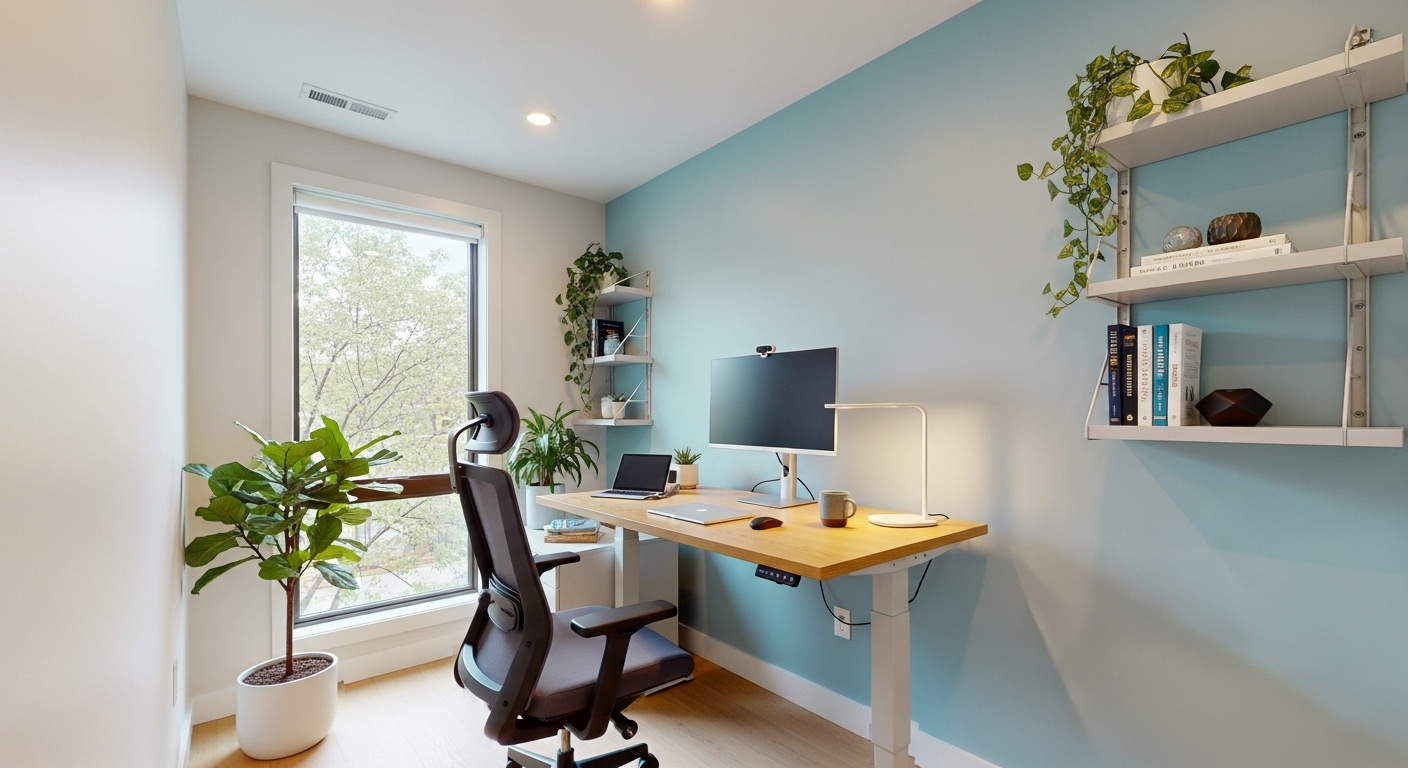Coworking spaces offer a compelling paradox: they are vibrant hubs of community and collaboration, yet that same energy can be the biggest obstacle to individual productivity. For the modern professional, the challenge isn’t just finding a desk, but mastering the art of deep work amidst the buzz. As flexible work models become the norm, learning to thrive in a shared environment is no longer a niche skill but a professional necessity. This guide introduces the concept of a ‘focus filter’—a personalized system of habits, tools, and boundaries designed to help you harness the benefits of coworking without sacrificing concentration. We’ll explore practical strategies to build impenetrable focus, from curating your physical and digital environments to navigating the social landscape with intention. By the end, you’ll have a complete toolkit to transform a potentially distracting space into your personal productivity sanctuary.
Establishing your productivity ritual
In a traditional office, the commute and fixed hours create a natural structure for the workday. In a coworking space, you are the architect of your own schedule, which makes establishing a firm routine absolutely critical. A productivity ritual acts as the psychological trigger that tells your brain it’s time to focus. Start with a ‘workday startup’ routine. This isn’t just about opening your laptop; it could involve grabbing a coffee from the communal kitchen, spending five minutes tidying your desk, and reviewing your top three priorities for the day. This simple sequence signals a clear transition from personal time to work time. Equally important is a ‘shutdown’ ritual. Instead of just abruptly closing your laptop and leaving, take 15 minutes to review your accomplishments, plan the next day’s tasks, and clear your desk. This creates closure and prevents work from mentally spilling over into your personal life. Within this framework, time-blocking techniques are invaluable. The Pomodoro Technique, for instance—working in 25-minute focused bursts with 5-minute breaks—is perfectly suited for coworking environments. It structures your time into manageable sprints, making it easier to ignore minor distractions, knowing a break is imminent. These rituals are the foundational layer of your focus filter, creating predictable patterns that foster concentration.
Curating your physical environment
Your immediate physical space has a profound impact on your ability to concentrate. While you can’t control the entire office, you have significant influence over your personal bubble. The first step is strategic desk selection. If possible, choose a spot away from high-traffic areas like the kitchen, entrance, or main walkways. A desk facing a wall or in a corner can dramatically reduce visual distractions. Once you’ve claimed your space, the single most powerful tool in your arsenal is a pair of high-quality, noise-canceling headphones. They are the universal sign for ‘do not disturb’ and are essential for blocking out ambient chatter and sudden noises. Think of them as the primary hardware of your focus filter. Beyond sound, consider your physical organization. A cluttered desk leads to a cluttered mind. Use desk organizers to keep essentials within reach and everything else stored away. This concept of ‘desk zoning’—assigning a specific place for your notebook, phone, and water bottle—minimizes the small, distracting decisions you have to make throughout the day. Even small environmental tweaks, like using a laptop stand to improve posture or having a small plant on your desk, can contribute to a more comfortable and focus-conducive workspace. Your goal is to create a micro-environment that signals calm and order to your brain, making it easier to slip into a state of flow.
Mastering digital boundaries and tools
In a shared workspace, physical distractions are only half the battle; the digital world provides a constant stream of interruptions. Creating a digital focus filter is just as crucial as managing your physical one. Begin by conducting a notification audit. Turn off all non-essential alerts on your laptop and smartphone. Every ping, pop-up, and banner is a potential focus-breaker. For communication platforms like Slack or Teams, customize your settings aggressively. Use ‘Do Not Disturb’ modes during focus blocks and mute channels that aren’t critical to your immediate task. The goal is to shift from a reactive mode, where you respond to every notification, to a proactive one, where you check messages on your own schedule. Beyond notifications, leverage technology to protect your attention. Use website and app blockers like Freedom or Cold Turkey to create a distraction-free digital environment during your deep work sessions. These tools act as a guardrail, preventing the mindless drift to social media or news sites. Finally, practice digital minimalism on your desktop. A clean, organized desktop with only the files and apps for your current project reduces visual clutter and cognitive load. By intentionally building these digital boundaries, you reclaim your attention from the countless forces competing for it.
Navigating the social landscape
One of the primary draws of a coworking space is the community, but that same community can be a major source of distraction. Navigating this social landscape requires a delicate balance of being approachable yet protective of your time. Headphones are your first line of defense, but sometimes you need to be more explicit. A small, polite desk sign that says ‘In a Focus Session’ or ‘On a Deadline’ can work wonders. It’s a non-confrontational way to communicate your need for uninterrupted time. Another effective strategy is to be proactive with your social interactions. Instead of allowing random conversations to derail your workflow, schedule your social time. Intentionally take your coffee breaks in the communal kitchen or invite a coworker to lunch. This allows you to reap the networking and community benefits of the space on your own terms. When a chatty colleague does approach while you’re in the zone, have a polite ‘exit script’ ready. Something as simple as, “It’s great to see you! I’m right in the middle of something urgent, but can I catch you at lunch in about an hour?” This acknowledges the person while firmly protecting your focus block. Mastering these social cues allows you to be a friendly, engaged member of the community without letting your productivity become a casualty of conversation.
Leveraging your coworking space’s design
Modern coworking spaces are often intentionally designed with different zones for different types of work. A key to productivity is learning to use the space as the architects intended. Your focus filter becomes much more effective when you align your tasks with the appropriate environment. Treat your dedicated desk as your primary hub for focused work, but don’t be afraid to migrate throughout the day. When you need to make a phone call or join a virtual meeting, use the designated phone booths or private call rooms. This not only gives you privacy and better acoustics but also respects the concentration of those around you. For tasks that require intense, uninterrupted thought—like writing a report or coding—seek out the designated ‘quiet zone’ or ‘library area’ that most spaces now offer. These areas have stricter rules about noise and conversation, making them ideal for deep work. Conversely, when you need to brainstorm with a colleague or have a more casual meeting, move to the soft seating in the common area or book a collaboration room. By consciously matching your task to the zone, you work with the natural energy of the space rather than fighting against it. This ‘task-based migration’ not only boosts your own focus but also contributes to a more productive and respectful environment for everyone.
The mindset shift: from reactive to intentional
Ultimately, all the tools, techniques, and rituals are in service of a larger internal change: shifting from a reactive to an intentional mindset. It’s easy to walk into a bustling coworking space and let the environment dictate your day. The chatter pulls your attention, the social events fill your calendar, and the constant movement keeps you in a state of low-grade distraction. An intentional mindset means you arrive with a clear plan and the resolve to protect it. Your focus filter isn’t a wall you build to isolate yourself; it’s a sophisticated system you manage to control the flow of information and interaction. It’s the conscious decision to put on headphones before you start a task, not after you’ve already been distracted. It’s choosing to check email in batches rather than responding to each one as it arrives. This proactive approach acknowledges that focus is not the default state in a shared environment—it is a state that must be actively created and defended. Adopting this perspective transforms productivity from a game of chance into a skill. You stop blaming the environment for your lack of focus and start taking ownership of your attention. This mental shift is the final, most crucial component that binds all the other strategies together, allowing you to consistently perform at your best, no matter how busy the space around you becomes.
Thriving in a coworking space is a skill that blends self-discipline with environmental awareness. The key isn’t to find a perfectly silent corner but to build a robust ‘focus filter’ that allows you to engage with your environment on your own terms. By establishing firm productivity rituals, you create a predictable structure in a flexible world. By meticulously curating your physical and digital spaces, you minimize the friction that leads to distraction. Navigating the social landscape with clear boundaries enables you to enjoy the community without sacrificing your agenda, and leveraging the intentional design of the space helps you align your tasks with the right energy. Ultimately, these practices culminate in a powerful mindset shift—from being a passive recipient of environmental stimuli to becoming the active architect of your own focus. With this intentional approach, you can unlock the true promise of coworking: the perfect synthesis of community, flexibility, and deep, meaningful work. You get to control the dimmer switch on the world, turning it down for concentration and up for collaboration, ensuring you always have the right light for the task at hand.





